Silkie Chicken
Gallus gallus
Silkie hens are excellent mothers and will raise any bird as their own, even being known to patiently sit on a clutch of duck or geese eggs until they hatch.
Advertisement
Silkie Chicken Scientific Classification
- Kingdom
- Animalia
- Phylum
- Chordata
- Class
- Aves
- Order
- Galliformes
- Family
- Phasianidae
- Genus
- Gallus
- Scientific Name
- Gallus gallus
Read our Complete Guide to Classification of Animals.
Silkie Chicken Conservation Status
Silkie Chicken Facts
- Name Of Young
- chick
- Group Behavior
- Flock
- Fun Fact
- Silkie hens are excellent mothers and will raise any bird as their own, even being known to patiently sit on a clutch of duck or geese eggs until they hatch.
- Biggest Threat
- racoons
- Most Distinctive Feature
- Fluffy feathers
- Other Name(s)
- Silky or Chinese Silk Chicken
- Gestation Period
- Incubation period- 20 to 21 days
- Temperament
- Docile
- Wingspan
- 15 - 20 inches
- Litter Size
- 10-14 eggs
- Habitat
- farm, yards
- Predators
- Racoons, Bobcats, Foxes, Coyotes, Weasels, Birds of Prey, Skunks, Snakes, and Rodents
- Diet
- Omnivore
- Type
- bird
- Common Name
- Silkie
- Origin
- China
- Group
- flock
Silkie Chicken Physical Characteristics
- Color
- Grey
- Blue
- Black
- White
- Skin Type
- Feathers
- Lifespan
- 7-9 years
- Weight
- 1.5-3 pounds
- Height
- 8-14 inches
- Age of Sexual Maturity
- Hens- 8 to 10 months, Cockerels- 10 to 12 months
- Age of Weaning
- Wean from heat lamps at 6 weeks
View all of the Silkie Chicken images!
Silkie chickens have a tuft of feathers on their head that looks like hair and are soft as silk!
Summary
For a nice pet chicken that you will enjoy watching and raising, consider the Silkie or Chinese Silkie. It is a docile bird with a pleasant personality that takes care of eggs, even if they are from other chickens or poultry. Plus, they have some serious style! Silkies have a full head of fluffy plumage that is soft as silk. They get their name from their extra soft feathers.
4 Incredible Silkie Chicken Facts!
- Silkies have black or dark blue skin.
- They are popular backyard chickens because they have an easy disposition.
- Silkies make great nesting hens and often sit on other birds’ eggs to incubate them.
- Their eggs can range from white to dark tan.

Scientific Name
Silkies are known by their scientific name Gallus gallus. This is the name given to all breeds of chicken. Silkies are a specific breed that falls under that name. They are also known as “Chinese silkie chickens” because they originated in China, where they had an essential spot in symbolism and mythology. They became more and more common throughout Asia and beyond, traveling with explorers to new places. Now, they are popular both for their unique appearance and easy temperament. They belong to the Phasianidae family. Other members include pheasants, turkeys, peafowl, and other birds. They are part of the Galliformes order. This order has almost 300 species of landfowl, many of which are eaten or kept for their eggs, including chickens. The Aves class includes all birds.

Silkies are known by their scientific name
Gallus gallus.
©Andi111/Shutterstock.com
Appearance
These chickens are one-of-a-kind when it comes to appearance. They get their name from their silky, soft plumage around their face and neck, with a characteristic “tuft of hair” on the top of their head. Their feathers are also very, very soft. They can be a variety of colors, including white, black, gray, and orange-tan. When referring to chicken plumage, these colors are called white, black, blue, and buff. They can have some pattern or be solid-colored. Typically, they have the same coloring throughout their feathers. Silkie chickens have black skin, an unusual feature among breeds of chicken. You can see it more when they are molting or by moving their feathers aside. Silkies also have five toes on each foot, whereas most chicken breeds only have four. In addition, they are bantam chickens, which means that they are slightly smaller than other breeds.
Size and Weight
| Weight (Male): | 2-4 pounds |
| Weight (Female): | 1-3 pounds |
| Height (Male): | 8-14 inches |
| Height (Female): | 8-14 inches |

Silkie chickens have black skin and a characteristic “tuft of hair” on the top of their head.
©Nick Beer/Shutterstock.com
Types of Silkies
Silkies are divided into two types: bearded and non-bearded.
- Bearded – Maybe the cutest chicken on the planet, the Bearded Silkie has a face that looks like a puff ball with a little beak sticking out of it. Their “beards” cover their earlobes and faces and grow under their beaks as well.
- Non-bearded – While these chicks have a similar look as the bearded, the biggest difference is in their face. They look like they have shaved and their faces, earlobes, and waddles are more visible.
Silkies come in a variety of colors that provide a lot of beautiful combinations and looks! These are their general color options:
- White
- Black
- Blue
- Gray
- Buff
- Partridge
- Splash
History and Evolution
Silkie Chickens have existed for quite some time, although the exact region of origin is up for debate. It is known that they are from Asia and most likely China, but some argue that they may be from Japan or India. In the 1200s, Marco Polo even mentions them in his writings about his travels.
As far as evolutionary genes go, their Fibromelanosis gene gives them their notable black skin and they also have a gene that gives them “furry” feathers, also known as a type of hookless feathering. This feature actually causes the Silkie Chickens to be flightless.
Where to Find Them
While these chickens originated in China and other parts of Asia, they have become popular worldwide. You can find them in backyard flocks because they are an adorable addition to the family and easy to care for. In fact, these domestic chickens are usually kept as pets.
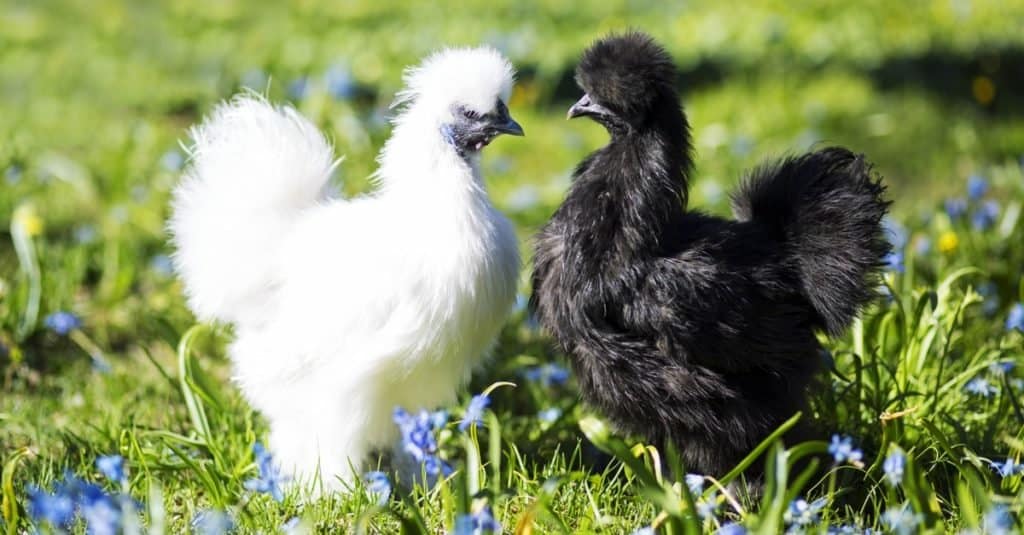
Silkies originated in China and other parts of Asia, and they have become popular worldwide.
©Einar Muoni/Shutterstock.com
Behavior
Silkies make great pets and members of a backyard flock. They are also quieter than many other chickens, making them a good choice for those with close neighbors. Of course, they can lay eggs but are known best for their maternal behavior, which makes excellent brooding hens. In fact, many people who keep chickens have Silkies in their flock because they can care for eggs from other members, including ducks, geese, and other chickens. They spend much time sitting on eggs in nests to incubate them and care for them, even if the eggs or nests are not their own. Silkies watch over nests and eggs from other flock members, ensuring the eggs are always taken care of.
Silkies also like nesting boxes. Generally, you should set up a place for them to nest and brood that is low to the ground and covered, as these chickens do not fly. It should be dry and protected from the elements. Chicken coops are a great way to create a safe place for Silkies and other breeds of chickens to nest.
For those with multiple chickens already, adding silkies to the flock can present challenges. The birds’ peaceful temperament can make them the target for bullying by other types of chickens. Providing sufficient room and resting spots can help, but care should be taken to ensure the silkies are getting enough to eat and are not being bullied.
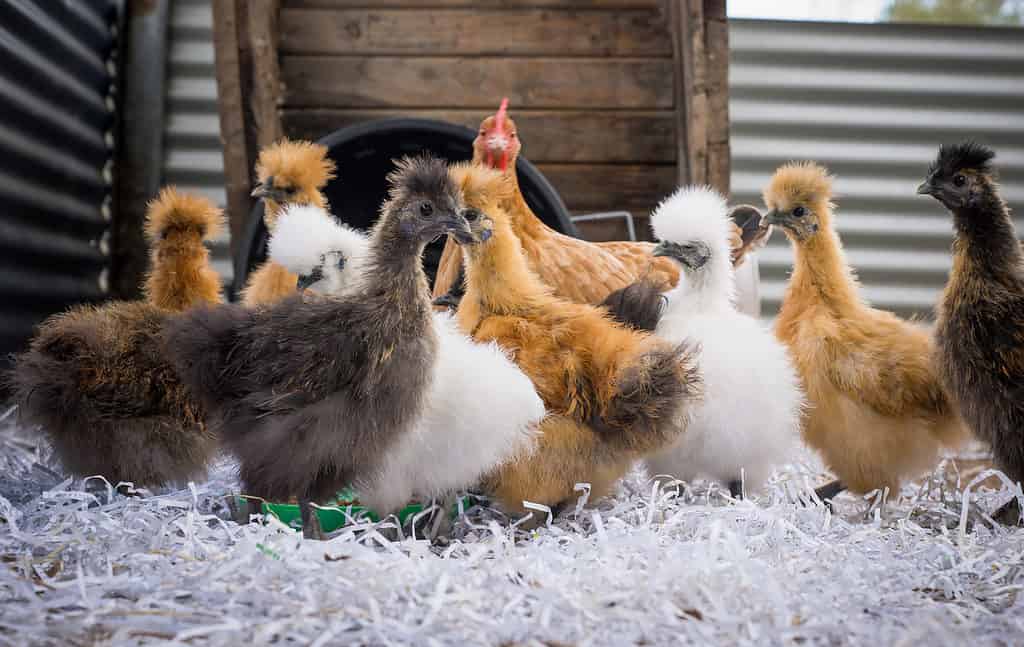
Silkie Chickens are known best for their maternal behavior, which makes excellent brooding hens.
©SherSS/Shutterstock.com
Reproduction
Hens are sexually mature at eight to ten months, but it may be a year or more before they begin laying eggs. Males reach sexual maturity between 10 and 12 months. Silkies lay between three and eight eggs a week, although that can vary widely based on the bird and the conditions. For example, in the hot summer months, they may stop producing entirely. Their eggs tend to be medium-sized and tan. There is a range, however, and you may be surprised to see a stark white egg or a darker brown egg from the same breed.
Silkies are very doting parents. Hens brood over eggs and nests, sitting on them to keep them warm as they mature into chicks. During the time the hens sit on the clutch, you may notice them turning them to make sure the eggs are evenly warmed. If you notice that the hens push an egg out of the nest, it means it is unviable and shouldn’t be returned. After about 21 days, the eggs will hatch. When the young hatch, Silkies are very attentive. Male Silkies also help raise the chicks and are more involved than some other breeds.
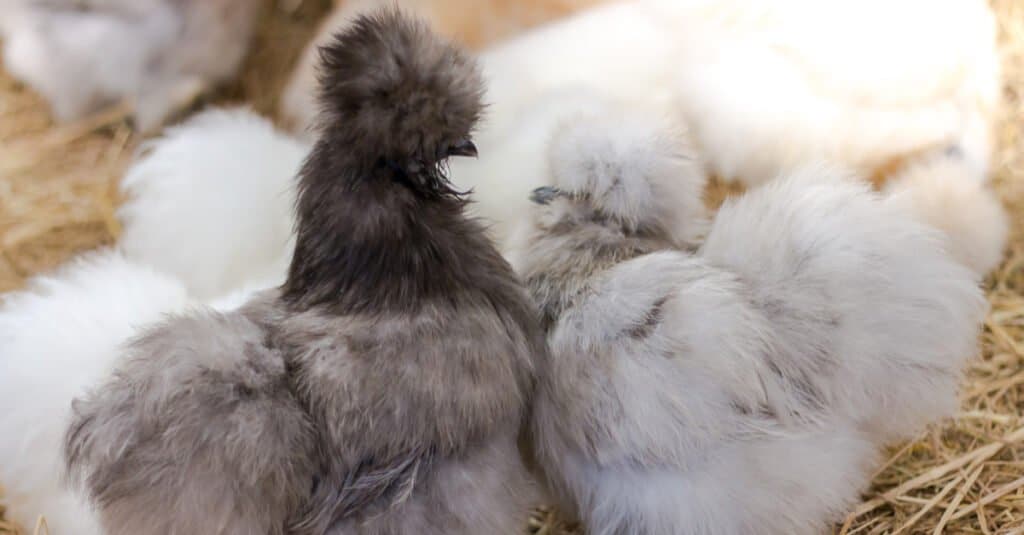
Silkies lay between three and eight eggs a week, although that can vary widely based on the bird and the conditions.
©9wittgiggs/Shutterstock.com
Young and Molting
Provide starter crumble to give your chicks the nutrients they need to sustain their rapid growth. Their mother will take care of their other needs, keeping them warm and shepherding them to food and water. Having a heat lamp to provide supplemental warmth is a good way to give your Silkies the best chances of success. While their mother will tuck them underneath her wings to provide warmth, additional warmth is beneficial for chilly nights and very young chickens. After hatching, having an area where the temperature is a consistent 95 degrees Fahrenheit and draft-free helps keep the chicks healthy.
As the chicks grow, you will notice them begin to develop their real feathers. At the same time, you can add a few handfuls of grass to the brood area as well as a container of grit if you haven’t already done so. By the time the silkies are about five weeks old, they will be able to maintain their own body temperature and not need supplemental heat from their mother or a heat lamp.
With all those feathers, it should be no surprise that when Silkies molt, they really go for it. Their first molt comes when they are still baby chicks, between 1 and 6 weeks old. They lose the downy feathers they hatch with and start to grow the silky feathers that give them their name. They molt three more times before they are adults. After that, they molt each fall. Silkies have a lifespan of seven to nine years.
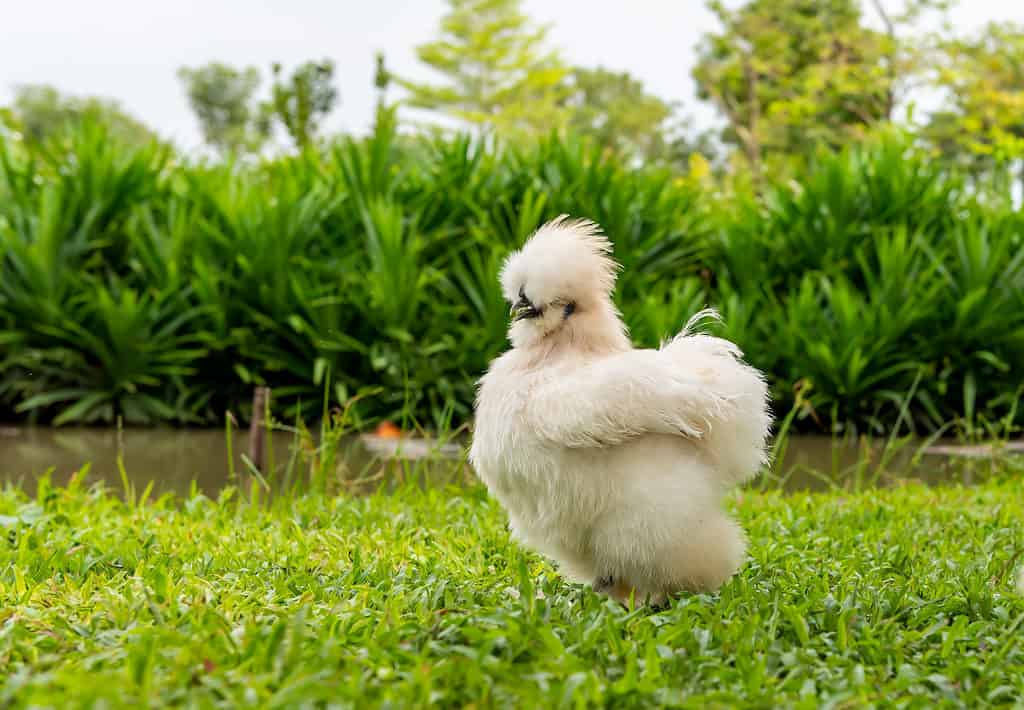
Silkie Chickens’ first molt comes when they are still baby chicks, between 1 and 6 weeks old.
©MR. AEKALAK CHIAMCHAROEN/Shutterstock.com
Population
Silkies are a popular backyard chicken, which helps keep their population numbers high. They are kept throughout the world as layers and brooding chickens. They have easy personalities and get along with a lot of other breeds, as well as other pets and children.
Diet
Because they are domesticated, most Silkies eat a specialized feed made for chickens. It is formulated to meet their nutritional needs and can have added nutrients and vitamins that help chickens thrive. Because of their small size, Silkies often prefer layer crumbles rather than pellets. You can supplement their regular diet with fruits and vegetables like grated carrots, apples, and table scraps. Adding a little vegetable oil and meat meal a few times a week can help them maintain a healthy weight. Silkies also enjoy mealworms.
If you have Silkies as part of a larger flock that includes different breeds, you don’t need to separate their food. You can use the same feed for all of the chickens, and they can eat together. Depending on their temperaments, you may need to put out multiple feed sections. But for the most part, Silkies are happy as part of a flock and don’t get bothered by sharing.

For the most part, Silkies can be fed the same food alongside chickens of differing breeds.
©kai foret/Shutterstock.com
Predators and Threats
Silkies are on the smaller side, making them especially vulnerable to predators at night. The animals that go after Silkies include the typical predators of domestic chicken flocks, such as foxes, raccoons, and coyotes. Even some dogs and cats will go after chickens. One way to prevent predators from getting to your chickens is to provide them with a secure place to sleep. Many chicken coops have special features that prevent predators from getting in and making a meal of your chickens. If you let your chickens roam, often called free range, they have a higher chance of running into a predator.
Silkies’ eggs can also be vulnerable to predators. Animals like snakes, birds, small rodents, and others love to get their hands or claws on an unattended chicken egg. Make sure that you know where your chickens are laying so that you can take steps to protect the nest from predators. Providing nesting boxes that are cozy and set up well is a great way to encourage your layers to lay their eggs in a place that you already know is safe.
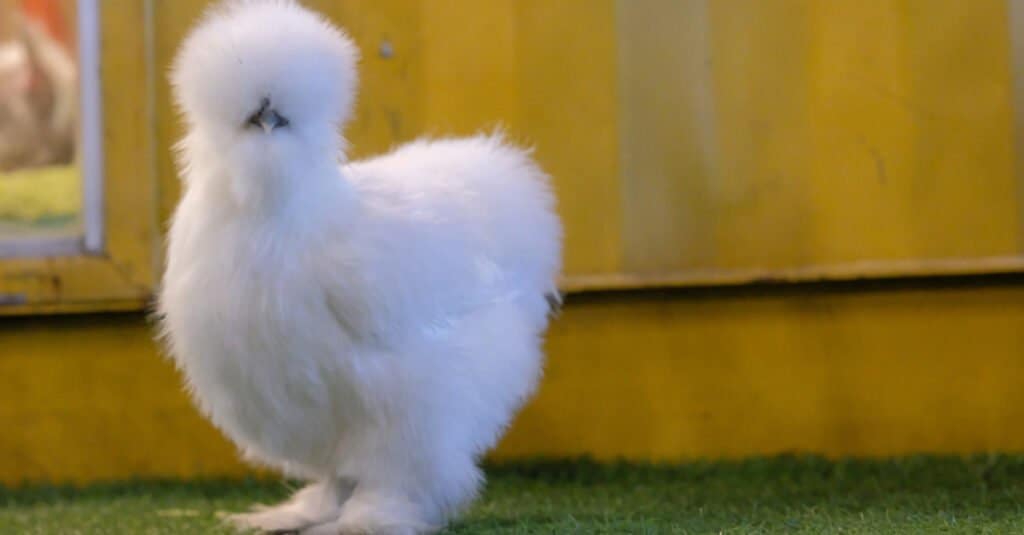
Typical predators of Silkie are the usual suspects, such as foxes, raccoons, and coyotes.
©Hand Robot/Shutterstock.com
Related Animals:
View all 293 animals that start with SSilkie Chicken FAQs (Frequently Asked Questions)
Silkie chicken hens vs roosters
Silkie roosters are larger than silkie hens. In addition, silkie roosters have wattles and lack the distinctive crown feathers of hens.
Are silkie chickens carnivores, herbivores, or omnivores?
They are omnivores.
What are silkie chickens good for?
In some areas, their meat is considered a delicacy in China, their country of origin. The eggs, while smaller than a typical chicken egg, are just as flavorful and nutritious. Many people keep them for novelty or to show.
How much are silkie chickens worth?
The price of a silkie surprises many people. Rather than think of a silkie as a chicken, it is helpful to treat it like a pet. Their friendly, docile nature and enjoyment of being around humans make them a popular choice and good companion. The price of silkie chick ranges from $3 to $10. If you want an adult hen, expect to pay between $15 and $50 for one.
Do silkie chickens lay eggs to eat?
Yes, although the eggs are not as big as the ones you see at the store, they are perfectly edible and safe to eat.
Why is silkie chicken meat black?
The black meat of the silkie is considered a delicacy to some. Black meat is the result of a genetic mutation resulting in hyperpigmentation. The bone, skin, and meat of the bird are black.
Why are silkie chickens so expensive?
Silkies are wonderful pets and make great companions. They are not highly productive egg layers, and many people avoid their meat, so there are fewer breeders interesting in producing them. The low supply leads to higher prices.
How long do silkie chickens live?
7 to 9 years.
What is a silkie chicken?
Also known as the Chinese silk chicken, this small chicken with unique feathers has a fluffy appearance and gentle behavior. In addition to their unusual looks, the birds are quieter and calmer than many other breeds of chicken.
Where do I buy a silkie chicken?
Expect to pay a higher price for silkies than other chickens. You can find them online from hatcheries or at your local farm store at certain times of the year.
What does a silkie chicken look like?
The silkie has a compact, sturdy body covered in fluffy feathers. In addition to their unique feathers, they have black skin and bright turquoise ears. They come in a range of colors. They may be black, gray, blue, buff, white, partridge, lavender, or splash.
How do I determine the sex of a silkie chicken?
The male has a more upright body carriage, with their neck elongated and chest out. The female has a more horizontal posture. Also, the female’s comb is shaped like a “V”, while the males is shaped like a “U”.
How do I bathe a silkie chicken?
You should not bathe a silkie chicken. Their fluffy plumage does not provide the insulation that other bird’s feathers provide. They can easily develop hypothermia in a situation where they become wet. If your silkie does get wet, it is important to grab a towel and dry it as quickly as possible.
Thank you for reading! Have some feedback for us? Contact the AZ Animals editorial team.
Sources
- modern farmer / Accessed October 4, 2021
- / Accessed February 12, 2023
- / Accessed February 12, 2023
- / Accessed February 12, 2023


















